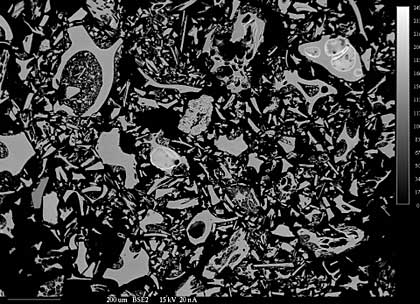
Tephra layers in Rio Grande Rift Sediments
On This Page

The Jemez Mountains volcanic field, in northwestern New Mexico, has been active for at least the past 16.5 million years, and has produced a large number of explosive and effusive volcanic eruptions during that time. Volcanic ash from the Jemez Mountains volcanic field provides a temporal record of the young eruptions from the caldera and many such deposits have been recognized in a number locations in New Mexico. The ash is present as thick deposits near the eruptive source, and as thinner deposits interbedded in ancestral Rio Grande river sediments at greater distances from the vent (Gardner and Goff, 1996; Dunbar et al., 1996; Izett, 1981). These ages of these volcanic deposits define the recurrence intervals of eruptions, information critical for volcanic hazards evaluations, from the Jemez Mountains volcanic field. Although the chronology of many of the main eruptions from the Jemez Mountains volcanic field and the Valles caldera are well-constrained (Spell et al., 1990; Spell and Harrison, 1993; Izett and Obradovich, 1994), the youngest deposits have proven difficult to date, and may provide the best clues into the current state of activity of the Valles caldera (Wolff and Gardner, 1995).
In addition to providing a record of volcanic activity, volcanic ash (tephra) layers also provide chronological control on the age of sediments in which they are found. A number of silicic tephra deposits have been found in ancestral Rio Grande river deposits in the Socorro area (Dunbar et al., 1996), as far south as Las Cruces (Mack et al., 1996), and in a number of other locations (Cather and McIntosh, 1990; Dunbar et al., 1996; J. Hawley; G. Mack; S. Connell, 1996, pers. comm.). Some of these have been identified and tied to source locations in the Jemez Mountains volcanic field (Dunbar et al., 1996). However, many layers that have been found have not been dated or tied to a source eruption. Furthermore, many new layers are likely to be discovered during ongoing mapping in the Albuquerque, Socorro, and Espanola basins. These tephra layers are found interbedded with a number of types of sedimentary deposits, from clay-rich, low-energy overbank deposits to the deposits of high-energy, catastrophic floods (Cather and McIntosh, 1990; Dunbar et al., 1996). The sedimentary sequences deposited by the Rio Grande are records of local climatic and tectonic events, but these records cannot be clearly resolved without controls on the timing of deposition. The interbedded tephra layers, if they can be directly dated, and/or geochemically tied to a dated source eruption, can provide time-lines in sedimentary sequences, allowing clear time resolution of the climatic record. Tephra layers can also be used to constrain the age of tectonic movements that affected sedimentation. A combination of 40Ar/39Ar dating and geochemical fingerprinting has already allowed several tephras layers to be tied to their source eruptions from the Jemez Mountains volcanic field (Dunbar et al., 1996; McIntosh and Dunbar, 1996). Geochemical and age correlations have been made to both the plinian and ignimbrite phases of the Bandelier Tuff. However, many layers have still to be dated and geochemically correlated to source eruptions. Further geological mapping and accompanying dating and geochemical analysis of more tephra units will facilitate development of a stratigraphic framework for ancestral Rio Grande sediments.
References
- Cather, S.M. and McIntosh, W.C., 1990. Volcanogenic flood deposits near San Antonio, New Mexico- Depositional processes and implications. Sediments 1990, 13th International Sedimentological Congress, Nottingham, England, p. 80.
- Dunbar, N.W., McIntosh, W.C., Cather, S.M., Chamberlin, R.M., Harrison, B., and Kyle, P.R., 1996. Distal tephras from the Jemez volcanic center as time-stratigraphic markers in ancestral Rio Grande sediments from the Socorro area, in F. Goff, B. S. Kues, M. A. Rogers, L. D. McFadden, and J. N. Gardner, eds., The Jemez Mountains Region, New Mexico Geological Society Field Guide 47, p. 69-70.
- Izett, G.A., 1981. Volcanic ash beds: recorders of Upper Cenozoic silicic pyroclastic volcanism in the western United States. J. Geophys. Res., 86, 10200-10222.
- Izett, G.A. and Obradovich, J.D., 1994. 40Ar/39Ar age constraints for the Jaramillo normal subchron and the Matuyama-Bruhnes geomagnetic boundary. J. Geophys. Res., 99, 2925-2934.
- Mack, G.H., McIntosh, W.C., Leeder, M.R., and Monger, H.C., 1986. Plio-pleistocene pumice floods in the ancestral Rio Grande Rift, USA. Sed. Geol., 103, 1-8.
- McIntosh, W.C. and Dunbar, N.W., 1996. Chronolgy of tephra deposits in Rio Grande basin-fill sequences, central and southern New Mexico. New Mexico Geology, 18, 50.
- Spell, T.L. and Harrison, T.M., 1993. 40Ar/39Ar geochronology of post-Valles caldera rhyolites, Jemez Volcanic Field, New Mexico. J. Geophys. Res., 98, 8031-8052.
- Spell, T.L., Harrison, M.T., and Wolff, J.A.,1990. 40Ar/39Ar dating of the Bandelier Tuff and San Diego Canyon ignimbrites, Jemez Mountains, New Mexico: temporal constraints on magmatic evolution. J. Volcanol. Geotherm. Res., 43, 175-193.
- Wolff, J.A. and Gardner, J.N., 1995. Is the Valles Caldera entering a new cycle of activity? Geology, 23, 411-414.


